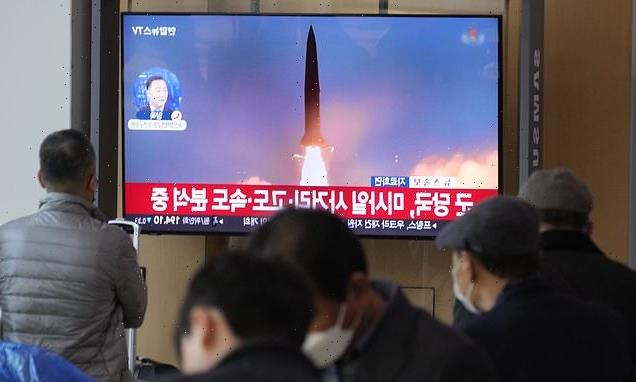
Kim Jong-un fires THREE ballistic missiles towards populated South Korean island, with one landing less than 40 miles off the coast of mainland as regional tensions soar
- Kim Jong-un has fired three ballistic missiles towards a populated South Korean island
- A rare air raid warning was issued on the island of Ulleung after Pyongyang launched three missiles
- The three missiles landed in the sea, with one landing less than 40 miles off the South’s coast
- Another landed 16 miles south of the disputed maritime Northern Limit Line, Japan’s Coast Guard said
- Launches come amid soaring regional tensions between North Korea, the South and the US
Kim Jong-un has fired three ballistic missiles towards a populated South Korean island in North Korea’s latest act of provocation.
A rare air raid warning was issued on the island of Ulleung after Pyongyang launched three missiles into the sea on Wednesday, including one that landed less than 40 miles off the South’s coast, Seoul’s military said. The launch was also reported by Japan’s Coast Guard.
The JCS said at least one of the missiles landed 16 miles south of the Northern Limit Line, a disputed inter-Korean maritime border. The missile landed only 35 miles from the South Korean city of Sokcho, on the east coast, and 103 miles from Ulleung.
Yonhap news agency quoted an Ulleung County official as saying that employees evacuated to a basement when the warning sounded.
South Korean President Yoon Suk-yeol called a meeting of the National Security Council over the launch.
It came just hours after Kim’s regime demanded the US and South Korea stop large-scale military exercises, saying such ‘military rashness and provocation can be no longer tolerated’.
The White House pushed back against North Korea’s sabre-rattling, reiterating that drills are part of a routine training schedule with South Korea.
A TV screen shows a file image of North Korea’s missile launch during a news program at the Seoul Railway Station in Seoul
North Korean leader Kim Jong-un speaks during a visit to the Central Officers School of the ruling Workers’ Party in Pyongyang
KF-16 fighters taxi at an air base in Gunsan, North Jeolla Province, South Korea
‘We reject the notion that they serve as any sort of provocation. We have made clear that we have no hostile intent towards the DPRK and call on them to engage in serious and sustained diplomacy,’ White House National Security Council spokesperson Adrienne Watson said Tuesday, using North Korea’s official name, the Democratic People’s Republic of Korea.
‘The DPRK continues to not respond. At the same time, we will continue to work closely with our allies and partners to limit the North’s ability to advance its unlawful weapons programs and threaten regional stability.’
On Monday the US and South Korea began Vigilant Storm, one of their largest combined military air drills, with hundreds of warplanes from both sides staging mock attacks 24 hours a day.
North Korea has test-fired a record number of missiles this year, and has said that a recent flurry of launches were in response to the allied drills.
Animosities on the Korean Peninsula have been running high in recent months, with North Korea testing a string of nuclear-capable missiles and adopting a law authorising the pre-emptive use of its nuclear weapons in a broad range of situations.
Experts still doubt North Korea could use nuclear weapons first in the face of more superior US and South Korean forces.
North Korea has argued its recent weapons tests were meant to issue a warning to Washington and Seoul over their series of joint military drills that it views as an invasion rehearsal, including this week’s exercises involving about 240 warplanes.
F-35B stealth fighter run by the US Marine Fighter Attack Squadron 242 landing at an air base in Gunsan, North Jeolla Province, South Korea
Pak Jong Chon, a secretary of the ruling Workers’ Party who is considered a close confidant of leader Kim Jong Un, called the so-called ‘Vigilant Storm’ air force drills ‘aggressive and provocative.’
Mr Pak also accused the Pentagon of formulating a North Korean regime collapse as a major policy objective in an apparent reference to the Pentagon’s recently released National Defence Strategy report. The report stated any nuclear attack by North Korea against the United States or its allies and partners ‘will result in the end of that regime’.
He slammed South Korean military leaders over what he called ‘rubbish’ comments that threatened to destroy North Korea if it uses nuclear weapons. South Korea’s military has warned North Korea that using its nuclear weapons would put it on a ‘path of self-destruction’.
‘If the US and South Korea attempt to use armed forces against (North Korea) without any fear, the special means of the (North’s) armed forces will carry out their strategic mission without delay,’ Mr Pak said, in an apparent reference to his country’s nuclear weapons.
‘The US and South Korea will have to face a terrible case and pay the most horrible price in history,’ he said.
US and South Korean officials have steadfastly said their drills are defensive in nature and that they have no intentions of attacking North Korea.
Mr Pak’s statement is the North’s second warning to the United States and South Korea this week. On Monday, the North’s Foreign Ministry warned of ‘more powerful follow-up measures’ in response to its rivals’ air force drills.
South Korean officials have said North Korea could up the ante in coming weeks by detonating its first nuclear test device since September 2017, which could possibly take the country a step closer to its goals of building a full-fledged nuclear arsenal capable of threatening regional US allies and the American mainland.
Some experts say North Korea would eventually want to use its expanded nuclear arsenal as a leverage in future negotiations with the United States to win sanctions relief and other concessions.
Source: Read Full Article



